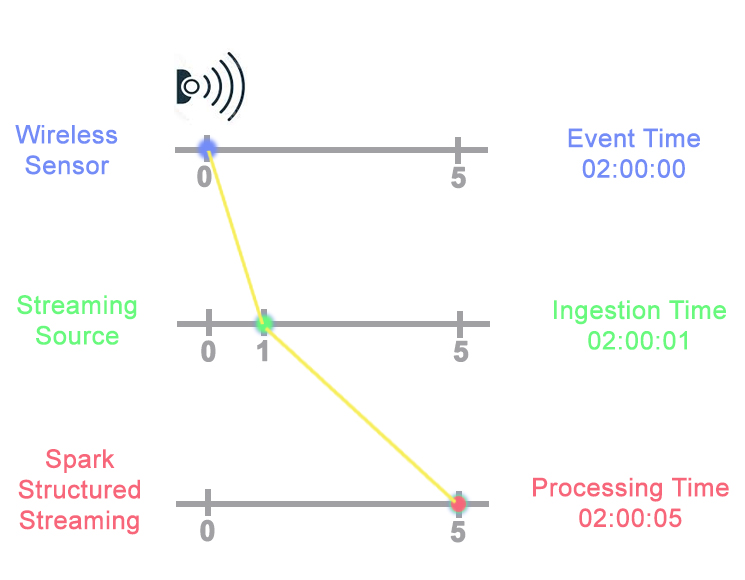A streaming application is an always running application. So in order to understand the behavior of the application over time, we need to take snapshots of the stream in various points. Normally these various points are defined using a time component.
Types of Time in Structured Streaming
There are three types of time stamps Event time, Ingestion Time and Processing time. Every event that is generated and processed has these time stamps associated with it.
-
Event time : Timestamp at which event happened. Event-time is the time embedded in the data itself. Normally the data which we collect from sources like sensors, logs have a time embedded in them. This time signifies when a given event is generated at the source.
-
Ingestion Time : Timestamp at which reaches to source. Ingestion time is a time captured at the ingestion of data. Ingestion time is the time when events ingested into the system. This time is in between of the event time and processing time.
-
Processing time : Timestamp at which events processed and processing time is the one when event is processed by the Spark. Processing time is time tracked by processing engine. In this abstraction of time, time passed is signified by the central clock maintained at the driver.
Let’s take an example to understand Time

-
Assume wireless sensor generating some events, in that event it specifies unique ID, and Timestamp , let’s say time is 2 a.m. when the event is generated. So this timestamp at which the event actually happened is called the event or application time, and this timestamp is present in the payload itself.
-
So next wireless sensor sends this event to the streaming source like Apache kafka assume that it took one second for the event to reach the source (due to some network latency). So the time at which the even reaches the source is known as injection or arrival time.
-
Next even though event has reached the source, it will be picked up by spark for possessing only when the job triggers. assume spark took five seconds to kick off the job. This is what is known as processing time.
So you have 2 a.m. as the Event time, one second past 2 a.m. as Ingestion Time and five seconds past 2 a.m. as the Processing time.
Scenario while working with Time
Clock Skew :
- Suppose the sensor generates an event at 02:00:06 that means six seconds past two as the even time.
-
Next Event took one second for the event to reach the source, but the injection time is 02:00:01that means one second past two.
How can this be possible ?
- It may be clock’s error because many time it not in sync.
- sensor device maybe using a different time zone and not mentioned in the payload.
Late Events:
-
Suppose sensor generates and event “event A” at 02:00:00 as a Event time. Then, after a second, it generates another event “event B” 02:00:01 that means one second past two as there event time.
-
Assume the sensor app(which generates the events) is multi threaded, multiple threads are delivering the events to streaming source.
-
Next the event A reaches the source at 02:00:04 so that’s the Ingestion time.
-
Next comes the problem. The thread off event A was responding slow, so it reached at 02:00:06 as a Ingestion time. these events are known as a late or out of order events.

Comments